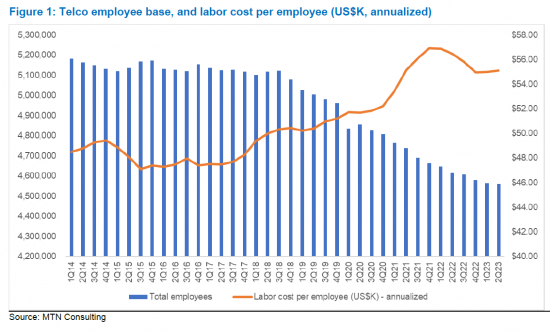 |
市場調查報告書
商品編碼
1388504
生成式人工智慧席捲電信產業:網路優化和差異化客戶體驗是一個有希望的起點,但監管不確定性是主要障礙Gen AI Hype Grips Telecom Industry as Telcos Unravel its Potential: Network Optimization and Differentiated Customer Experience are Promising Starting Points, but Regulatory Uncertainty Will Be a Major Impediment |
||||||
在本報告中,我們將考慮生成式人工智慧在兩類電信領域進行轉型的可能性,以及電信公司內部開發生成式人工智慧的努力、與引入生成式人工智慧相關的勞動力趨勢,以及我們研究了電信公司實施生成式人工智慧的監管影響,以及供應商在確保成功的技術整合和實施方面的作用。

自從去年底生成式人工智慧透過公共平台(如ChatGPT)進入主流以來,其突破性的能力引起了許多人的關注。 毫不奇怪,電信業高層是渴望嘗試生成式人工智慧的好奇觀察者之一,儘管它仍在快速發展。 然而,電信業與人工智慧之間的聯繫並不新鮮。 儘管許多電信公司在過去幾年中部署了傳統的人工智慧工具和應用程序,但生成式人工智慧為電信公司提供了一個創造遠遠超過現有人工智慧的價值的機會。 幾家主要電信公司已經開始探索生成式人工智慧,並專注於 "在地化" 。 透過使用生成式人工智慧進行流程在地化,電信公司旨在消除語言障礙並提高客戶參與度,特別是在英語口語不占主導地位的各自銷售市場中。
雖然電信公司可以在各種不同的功能中利用生成式人工智慧的力量,但網路和客戶服務可能會看到生成式人工智慧變革潛力的兩個關鍵電信業務領域。 這兩個領域都至關重要,隨著複雜性的增加,網路需求以前所未有的速度成長,提供差異化的客戶體驗仍然是電信公司無法實現的目標。 這兩個電信業務領域正在出現一些生成式人工智慧的用例來應對這些挑戰。 在網路領域,範例包括拓撲最佳化、網路容量規劃和預測性維護。 在客戶支援領域,這些包括本地化的虛擬助理、個人化支援和聯絡中心文件。
利用生成式人工智慧應用程式的大多數用例都涉及處理敏感數據,無論是與網路相關還是與客戶相關。 從監管角度來看,這也具有重大影響,監管問題限制了電信公司的生成式人工智慧採用和部署策略。 一個主要挑戰是不同市場中普遍存在的複雜而嚴格的法規,電信公司在這些市場中實施生成式人工智慧用例時必須了解並遵守這些法規。 在這個領域,第三方供應商希望透過提供符合各自市場法規的生成式人工智慧解決方案來受益。 供應商還透過消除缺乏技術專業知識、硬體/軟體資源和熟練人員的限制,並透過減輕營運支出成本的負擔,幫助中小型電信公司實施生成式人工智慧,似乎發揮了作用。 生成式 AI 領域值得關注的主要供應商提供了訓練大規模語言模型 (LLM) 所需的雲端運算資源與透過預訓練模型提供的生成式 AI 專業知識的理想組合。
文中提到的公司
|
|
目錄
- 摘要
- 電信公司乘著生成式人工智慧浪潮
- 網路營運和客戶支援將成為轉型的關鍵領域
- 在生成式人工智慧時代,電信員工將變得更精簡、更聰明
- 嚴格的監管對電信公司構成重大障礙
- 生成式人工智慧整合的主要供應商:網路規模供應商旨在進一步使電信公司受益
- 鎖定風險和增加的軟體成本:選擇供應商時的關鍵考慮因素
- 附錄
This brief report explores the transformative potential of generative artificial intelligence (Gen AI) in two specific telco domains. The report also discusses the in-house Gen AI development efforts of telcos, workforce trends arising from Gen AI implementation, regulatory impact of telcos deploying Gen AI, and the role of vendors in successful integration and adoption of the technology.
VISUALS

Ever since Gen AI burst into the mainstream through public-facing platforms (e.g. ChatGPT) late last year, its groundbreaking capabilities have caught the attention of many. Not surprisingly, telecom industry execs are among the curious observers wanting to try Gen AI even as it continues to evolve at a rapid pace. The telecom industry's bond with AI is not new though. Many telcos have deployed conventional AI tools and applications in the past several years, but Gen AI presents opportunities for telcos to deliver significant incremental value over existing AI. A few large telcos have kickstarted their quest for Gen AI by focusing on "localization". Through localization of processes using Gen AI, telcos vow to eliminate language barriers and improve customer engagement in their respective operating markets, especially where English as a spoken language is not dominant.
Telcos can harness the power of Gen AI across a wide range of different functions, but the two vital telco domains likely to witness transformative potential of Gen AI are networks and customer service. Both these domains are crucial: network demands are rising at an unprecedented pace with increased complexity, and delivering differentiated customer experiences remains an unrealized ambition for telcos. Several Gen AI use cases are emerging within these two telco domains to address these challenges. In the network domain, these include topology optimization, network capacity planning, and predictive maintenance, for example. In the customer support domain, they include localized virtual assistants, personalized support, and contact center documentation.
Most of the use cases leveraging Gen AI applications involve dealing with sensitive data, be it network-related or customer-related. This will have major implications from the regulatory point of view, and regulatory concerns will constrain telcos' Gen AI adoption and deployment strategies. The big challenge is the mosaic of complex and strict regulations prevalent in different markets that telcos will have to understand and adhere to when implementing Gen AI use cases in such markets. This is an area where third-party vendors will try to cash in by offering Gen AI solutions that are compliant with regulations in the respective markets. Vendors will also play a key role for small- and medium-sized telcos in Gen AI implementation, by eliminating constraints due to the lack of technical expertise and HW/SW resources, skilled manpower, along with opex costs burden. Key vendors to watch out for in the Gen AI space are webscale providers who possess the ideal combination of providing cloud computing resources required to train large language models (LLM) coupled with their Gen AI expertise offered through pre-trained models.
Companies Mentioned:
|
|
Table of Contents
- Summary
- Telcos surf the Gen AI wave
- Network operations and customer support will be key transformative areas
- Telco workforce will become leaner but smarter in the Gen AI era
- Strict regulations will be a major barrier for telcos
- Vendors key to Gen AI integration; webscale providers set for more telco gains
- Lock-in risks and rising software costs are key considerations in choosing vendors
- Appendix
Figures:
- Figure 1: Telco employee base, and labor cost per employee (US$K, annualized)
Tables:
- Table 1: Self-developed Gen AI-based tools of select telcos
- Table 2: Gen AI-based tools of select telco vendors













